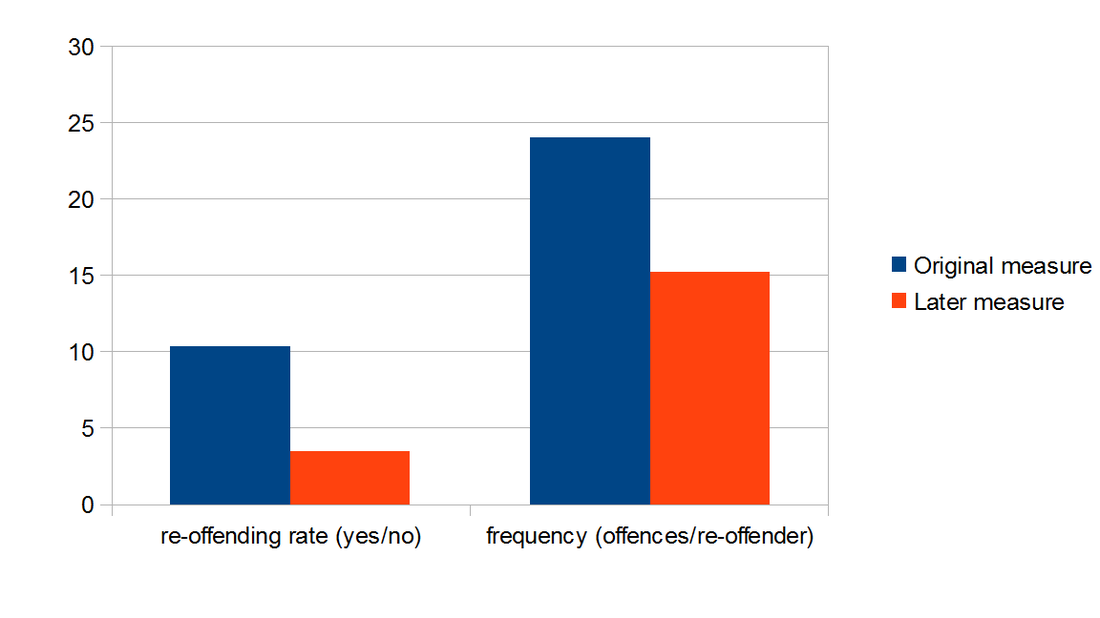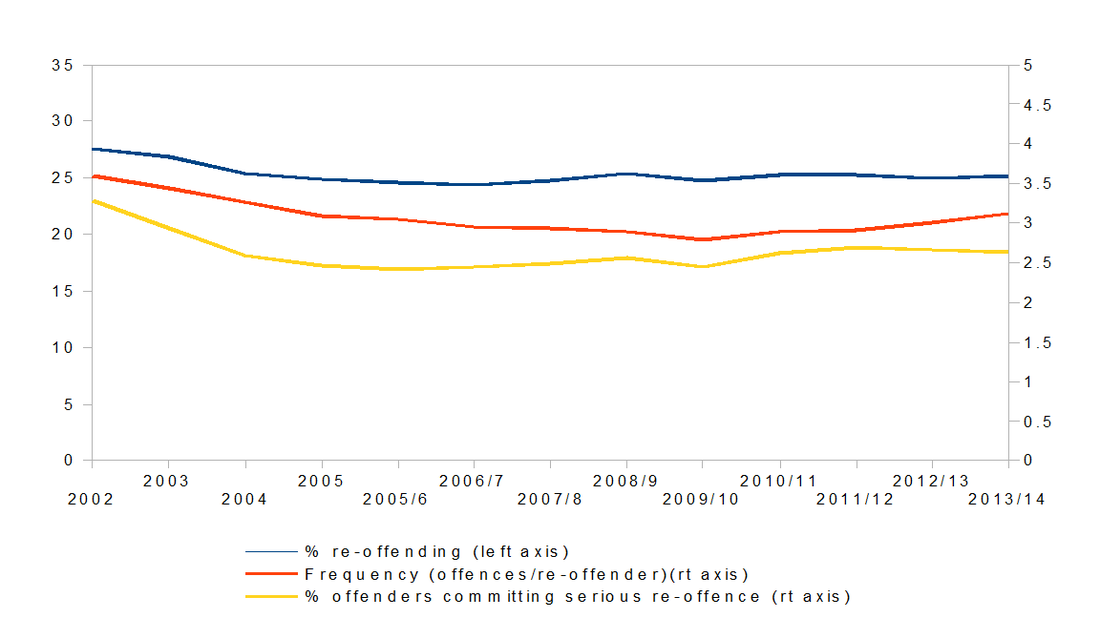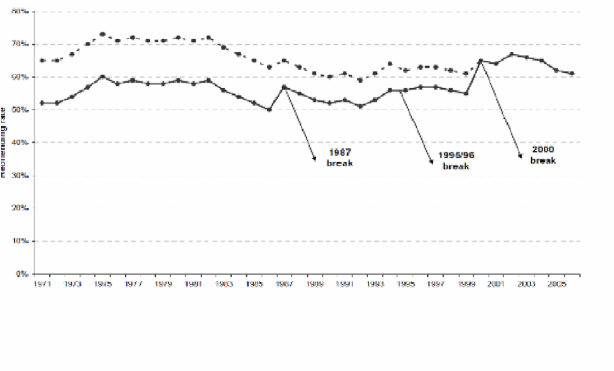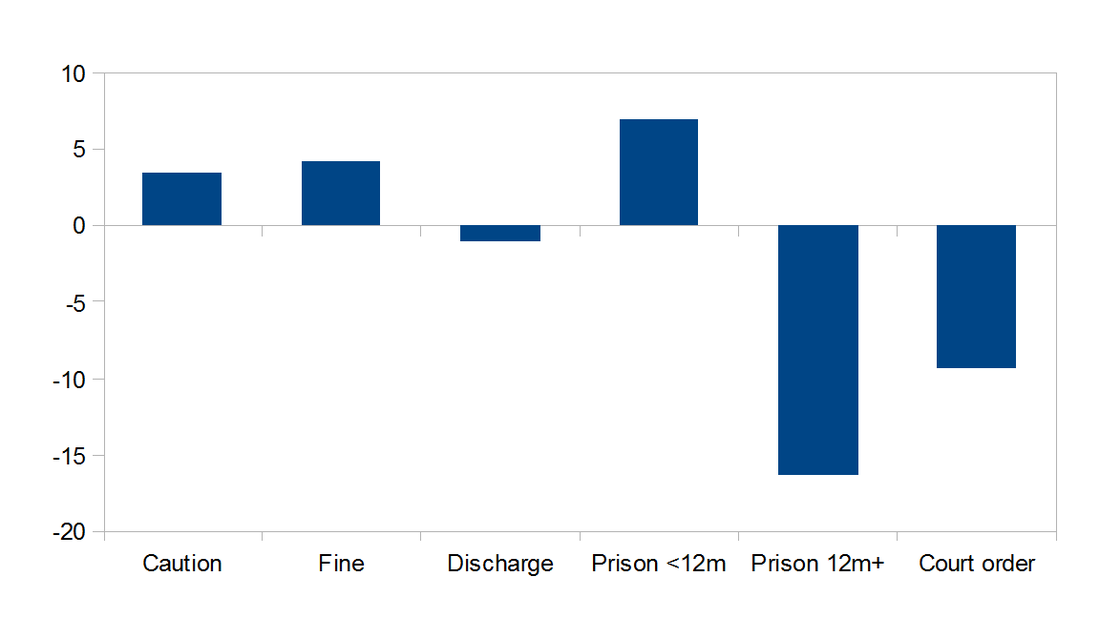|
A persistent characteristic of criminal justice policy in this country is the commitment to rehabilitation: the belief that every offender has the potential to repent his/her ways, and that the criminal justice system should encourage and support that change. It is remarkable, and heartening, that this idea has survived the drift to right in UK politics, so that it is as entrenched on the right as on the left of the political spectrum. That tradition was revived, after a period of deep pessimism in criminology ('nothing works') by the Blair Government in 1997, and taken to a new level - a 'rehabilitation revolution', if you will. Labour's belief in the capacity of huge state programmes to shape and improve society took the form, in the criminal justice system, of a new approach to reducing re-offending:
One might think that politicians since then who have so fervently declared their ambition to reduce re-offending would at least inquire what happened to the Labour programme. But I cannot recall any politician seriously inquiring into past efforts, at least for adult offenders. (Grayling's comment, in launching his probation changes, that there had been no progress in reducing re-offending rates prior to his arrival, was simply wrong, as I shall show.) Yet the data is there. What does it tell us? (I shall stick to adults for the moment because, God knows, that is complicated enough, and there are particular issues affecting juveniles.) Evaluation Measuring changes in human behaviour is complicated, and made more so by government's habit of changing the data definitions, and the way results are presented and explained, every few years. From the base year of 2000, changes in the way re-offending is measured have include: a switch from waiting two years from release from prisons (or start of community sentence), to measure how many are re-convicted to just on year; from measuring just whether they are re-convicted or not, to measuring changes in frequency and severity of re-offences; from measuring just convictions, to including cautions; from measuring using just the first quarter's data ,to using the data for the whole year; from expressing changes as percentage changes in the re-offending rate (thus, a fall from 50% to 48% was a 4% fall), to stating the change as percentage points (a 2 percentage point fall, on the same data). The results were shown two ways, as changes in raw data, and after adjustments to take account of changes in the mix of offenders which, other things be equal, would have made them more or less likely to offend. These changes sound terribly technical – but they do make a huge difference to the results: Chart 1: different results for % change in re-offending, 2000-09/10, using orginal and later measures Note: the fall in re-offending rate is here given as:
The lesson is that, as ever, you have to read the (very) small print on such statistics; and one should never assume they provide an absolute and unchallengeable truth about reality, as a thermometer or pressure gauge would. Nevertheless, the overall trend can be seen: Chart 2: Trend in re-offending rate, and frequency and seriousness of re-offending, 2000-13/14, adults, one year Note: 'raw' data i.e. not adjusted for changes in offender mix. After a rise at the start of the 2000s, re-offending rates, frequency of re-offending, and the seriousness of re-offences all fell in the mid 2000s. Since then, there has been no further fall. Was that reduction, though, a result of government action? After all, the re-offending rate fluctuates 'naturally' over time, for example over the quarter of a century before Labour came in in 1997: Chart 3: changes in re-offending rate at 2 years, 1971-2008 (The dotted line in this chart shows the rate adjusted for breaks in series.) What it shows is entirely counter-intuitive: that there was a sustained and significant re-conviction fall in re-conviction rates just at the very worst years of the prison crisis of the 1980s, and the period of 'nothing works' in criminology. (Or it could be an artefact of declining police detection rates?) At any rate, there is a case that the fall after 2000 was merely another natural fluctuation, and nothing to do with government policy. Yet that the reduction in table 2 was, at least in part, the result of the re-offending programmes is made plausible by the following:
Chart 4: % changes in re-conviction rates, adults 2000-2011, by disposal Note
-these are % falls in the % rate -of those given a court order, most were supervised by the probation service, but not all (The reduction achieved with prisoners is extraordinary, and something the prison service has never received credit for. On the contrary, we get the old myth lazily repeated on the left and right, that prison fails to acheive anything positive.) It is possible to estimate roughly how many offences were 'avoided' i.e. would otherwise have occurred but for the reduction in offending, and frequency of offending. In 2010, that was about 80,000 a year (that is, offences resulting in conviction or caution - but many more, if those that were never reported to or solved by the police showed a similar fall). Not an insignificant number, I suggest, of people who did not become victims of crime. Costly, yes: on my recollection of the sums involved, around £3000-4000 per crime avoided. I leave it to you, and the economists, to decide if that was worth it. But it is a small fraction of what is spent convicting and punishing those who re-offending is not reduced. Conclusions
Implications for policy now The main implication is surely negative – that in current circumstances, there is no reason to believe that further reductions in re-offending rates can be achieved as a result of government action. Consider: the Blair programme had the benefit of hundreds of millions of new money; of staffing ratios were much more generous than today; of new knowledge of 'what works'; of sustained political will. Yet the fall it achieved was small. No other initiative has made any impact. Today, there is no prospect of new investment ever being affordable; or of any relaxation of record low staffing ratios and unprecedentedly tight budgets; or of any relief to overcrowding; and the increase in knowledge of what works since 2000 has not been game changing. Cuts since 2010 are thought (by everyone outside the MoJ) to be making prisons less safe, and less likely to succeed in reforming prisoners. As for probation, the Grayling experiment of throwing all the cards up in the air simultaneously means tremendous risk; for most offenders, resources are likely to reduce, not increase; cross institutional working must become more difficult as the probation service has been fragmented; while 'payment by results' has yet to be shown to work in reducing re-offending. The one exception is prisoners serving less than 12 months. As we've seen, they were the one group for whom re-offending rates did not improve, for the obvious reason that they were not supervised after release. If, as is intended, the CRCs release significant resources through greater efficiency, and if they choose to reinvest that in better preparation for release and post release supervision for short sentence prisoners, and if they use interventions based on research into what works, and if the benefit of those interventions outweigh the increasing stress on the prison system and prisoners – a lot of 'ifs'! – we should see improvement in re offending rates for that one group in 3 years or so. To be clear, I am not saying, give up on trying to reduce re-offending. Interventions do work for some, that is after all what the data shows: and prison and probation staff have a moral and professional duty to do their best for the person in front of them. What I am saying is that it is simply not credible for government to think that it can achieve significant further reduction in the re-offending rate, other than for short term prisoners. Of course, such reductions may occur naturally, as a result of general societal changes - and if they do, government will no doubt claim them as an achievement! One could go further and question whether, in the light of the amazing fall in crime since 1995, and the equally striking reduction in public concern about crime (demonstrated in opinion polls), seeking a reduction in the re-offending rate is quite the priority it was 20 years ago, compared to other long-standing problems in the criminal justice system, such as the absymally low detection rate or the slowness of the criminal process or the high rate of cracked trials. Or for that matter, demands on other hard pressed public services, such as the NHS or schools. A second implication is that poor prospects for further reducing re-offending should prompt re-thinking of criminal justice policy. If (as the statistics plainly show) for the majority of offenders no disposal will reduce their future offending, it follows that sentencing must to be based on other aims. Government should therefore start thinking again about the business of sentencing, which it hasn't done seriously now for a generation, and not by accident – it has been a politically willed absence of thought. Yet during that time, use of custody has doubled, with the enormous costs associated with it. I will return to that in another post. A last query, on which comments are welcome: given the general rate of offending has fallen so dramatically since the '90s, why has the rate of re-offending remained so stubbornly high? I assume the explananation is that fewer people now turn to crime, but those that do embark on criminal careers find them just as hard to get out of as they ever did. Or is there some other explanation?
8 Comments
Readers of the late Oliver Sack's wonderful memoir of neurological deficits and disasters, 'The man who mistook his wife for a hat' – and if you haven't read it, what a treat you have in store! - will recall the dreadful case of Jimmie G., victim of Korsakoff's syndrome, which left him unable to form new memories, so that he recalled nothing of the past 30 years or so.
Sometimes it seems Korsakoff's has quite a hold on penal policy. Politician after politician arrives at the Ministry of Justice seemingly unaware of – or at least, not much interested in - what has gone before. For example, each in turn announces, as though as a new insight, that the rate of re-offending is really rather high, and that he wishes to reduce it, implying that his predecessors have for some strange reason not bothered to do so. Thus: Jack Straw: 'reducing re-offending is one of the Government's highest priorities' John Reid: cutting re-offending 'the central focus of our policy and practice' Charles Clarke: 'the central aim' of his 5 year strategy David Blunkett: 'the highest possible priority' Ken Clarke: re-offending is 'a national scandal...unacceptably high...there is an urgent need for steps to counter it' Grayling: 'under the previous Government, re-offending rates have barely changed. This can’t go on. ' Gove: 'horrified by our persistent failure to reduce re-offending' (One has to go back to Michael Howard for an exception – he of course just 'knew' that prison 'worked', independently of any effect on re-offending.) And what a cascade of proposals all these Sectaries of State have announced to get re-offending rates down! Reorganising prison and probation, more central control, less central control, cutting prison numbers, drug free wings , 'hard work' in prisons, using outside firms in prison industries, outsourcing to the private and third sectors, prisoner compacts, new community sentences, more or better education, new interventions, better mental healthcare services, help with housing, employment and resettlement, 'payment by results', 'community prisons' (Charles Clarke), 'working prisons' (Ken Clarke), 're-settlement prisons' (Grayling), 'reform prisons' (Gove)! One might have thought that, given every single Secretary of State for two decades has made this his top priority, there would have been a thorough investigation of whether any previous policies have had any effect - and if not, why not. If there has been such a review, I haven't seen it. Rather, we get a rapid conclusion that nothing very worthwhile has been achieved before, and quickly on to the next panacea. Which, in fact, sometimes looks much like the old ones. Such institutional amnesia matters, because it prevents us learning from experience. It is not just that 'he who forgets the past is doomed to repeat it' (and in truth, there is precious little genuinely new in penal policy.) Equally, it can lead to abandonment of past policies which actually did work. There are examples of both in prison and probation. There is a particular political context to this forgetfulness. In the 1990s, Labour moved sharply towards the right and on many issues, were not far apart from the Tories. The Blair Government took up, and much expanded, many inherited Tory penal policies – use of PFI for building prisons, Secure Training Centres, expansion of the prison population and prison system, emphasis on prison security and increased central control of both prison and probation systems. Thus on many issues, the two main parties shared responsibility for past policies. Might that in part account for the studied lack of interest in critically re-examining them? (It is curious that what one might call 'New Old' Labour has yet to recant on these policies, which may owe something to the fact that the Shadow Secretary of State, Lord Falconer, was Secretary of State under Blair.) In future posts, I shall explore what might be learned from objective review of past policies - starting with reducing re-offending. |
I was formerly Finance Director of the Prison Service and then Director of the National Offender Management Service responsible for competition. I also worked in the NHS and an IT company. I later worked for two outsourcing companies.
Archives
January 2023
Categories
All
Click below to receive regular updates
|




 RSS Feed
RSS Feed